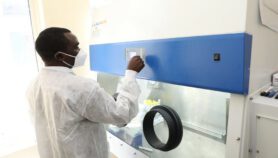By: James Njoroge
Send to a friend
The details you provide on this page will not be used to send unsolicited email, and will not be sold to a 3rd party. See privacy policy.
The United States has unveiled a plan to tackle greenhouse gas emissions, which will require the country’s businesses and industries to voluntarily set their own targets.
The so-called Climate VISION plan — which was presented by the Department of Energy on Wednesday (12 February) — is a follow-up to a commitment made by President George W. Bush to reduce America’s greenhouse gas intensity by 18 per cent within the next decade.
Climate VISION — which stands for Voluntary Innovative Sector Initiatives: Opportunities Now — is seen as part of a wider climate change strategy geared towards working with industrial energy partners to meet US greenhouse gas targets.
“The industry leaders of America are answering the President’s call to work with the federal government and take voluntary actions to reduce their greenhouse gas emissions,” said US Environmental Protection Agency administrator, Christine Todd Whitman at the plan’s launch.
But the initiative has been heavily criticised by environmental lobby groups, such as the World Wide Fund for Nature (WWF), which described it as a “dangerous masquerade” that will actually lead to an increase in carbon dioxide emissions.
“The world should not be fooled by these voluntary commitments,” said Jennifer Morgan, director of WWF’s Climate Change Programme, in a press statement.
Measuring greenhouse gas “intensity” — carbon dioxide emissions per product or unit of economic activity — rather than absolute emissions is deceptive, say campaigners; if production levels increase, total emissions are also permitted to increase, they complain.
On its part, Greenpeace said that a voluntary approach to greenhouse gas reductions and a continued and increasing US reliance on fossil fuels not only exacerbates global warming, but also threatens national security.
Climate VISION appears to reinforce President Bush’s assertion in his State of the Union address on 28 January that the greatest environmental progress “would come about not through the endless lawsuits or command-and-control regulations, but through technology and innovation.”













